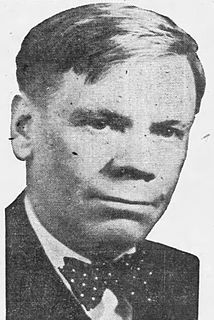
Thomas Edward Campbell was the second governor of the state of Arizona, United States. He is the first Republican and first native-born governor elected after Arizona achieved statehood in 1912.

Rawghlie Clement Stanford was the fifth governor of Arizona and served from 1937 to 1939. He later served on the Arizona Supreme Court from 1943 until 1955, including 3 years as Chief Justice.

The 1986 United States Senate elections was an election for the United States Senate in the middle of Ronald Reagan's second presidential term. The Republicans had to defend an unusually large number of freshman Senate incumbents who had been elected on President Ronald Reagan's coattails in 1980. Democrats won a net of eight seats, defeating seven freshman incumbents and regaining control of the Senate for the first time since January 1981. The party not controlling the presidency gained seats, as usually occurs in mid-term elections.

The United States Senate elections, 1968 were elections for the United States Senate which coincided with the presidential election. Although Richard Nixon won the presidential election narrowly, the Republicans picked up five net seats in the Senate. Republicans would gain another seat after the election when Alaska Republican Ted Stevens was appointed to replace Democrat Bob Bartlett.

The 1964 United States Senate elections coincided with the election of President Lyndon B. Johnson by an overwhelming majority, to a full term. His Democratic Party picked up a net two seats from the Republicans. As of 2019, this is the last time either party has had a two-thirds majority in the Senate, which would have hypothetically allowed the Senate Democrats to override a veto, convict and expel certain officials, or invoke cloture without any votes from Republicans. The Senate election coincided with Democratic gains in the House in the same year.

Although the 17th Amendment was not passed until 1913, some states elected their Senators directly before its passage. Oregon pioneered direct election and experimented with different measures over several years until it succeeded in 1907. Soon after, Nebraska followed suit and laid the foundation for other states to adopt measures reflecting the people's will. By 1912, as many as 29 states elected senators either as nominees of their party's primary or in conjunction with a general election.

United States gubernatorial elections were held on November 6, 2018 in 36 states and three territories. These elections formed part of the 2018 United States elections. Other coinciding elections were the 2018 United States Senate elections and the 2018 United States House of Representatives elections. The last regular gubernatorial elections for all but three of the states took place in 2014. Governors in New Hampshire and Vermont serve two-year terms, meaning that their most recent gubernatorial elections took place in 2016. Meanwhile, Oregon held a special election in 2016 to fill an unexpired term.

The 1911 Arizona gubernatorial election took place on December 12, 1911 for the post of the first elected Governor of Arizona. The Democratic nominee George W. P. Hunt defeated the Republican nominee Edmund W. Wells. Hunt and Wells were both members of the Constitutional Convention, Hunt being chosen President and leading the way for much of the drafting. Wells refused to sign the Constitution, considering aspects like the initiative, referendum, and especially judicial recall to be too radical.

The 1916 Arizona gubernatorial election took place on November 7, 1916 for the post of the Governor of Arizona. Due to battles between labor and business, the Hunt administration was facing severe electoral backlash. After facing a fairly strong primary by former Council member George Olney, Hunt prevailed and went on to face the closest election in Arizona gubernatorial history. The initial results of the 1916 election were extremely close, with Campbell winning by only 30 votes.

The 1918 Arizona gubernatorial election took place on November 5, 1918 for the post of the Governor of Arizona. Thomas Campbell, who served a partial term in 1917 and had his election overturned by the Supreme Court of Arizona, returned to contest the Governors office. Incumbent Governor Hunt declined to run again after the stress of the close elections and the year-long court battle. Despite falling to its lowest percentage in years, the sole third party challenger held the difference between the two candidates. The Democratic challenger was state senator Fred T. Colter, a pro-Hunt Democrat.

The 1924 Arizona gubernatorial election took place on November 4, 1924. Despite being a Republican year nationally, President Coolidge's election in Arizona was rather close. He only took Arizona with 40% of the vote against Davis' 35% and La Follette's 23%. The closest Arizona gubernatorial election since 1916, Hunt's lead in votes would continue to decline.

The 1926 Arizona gubernatorial election took place on November 2, 1926. Despite being a Democratic year generally, Hunt barely managed to be re-elected against his Republican opponent Elias Clark. Hunt had been governor for around 11 out of the State of Arizona's 14 years, coupled with his age and with issues regarding the Colorado River Compact, he was running out of steam. Despite that Hunt narrowly prevailed and won.

The 1928 Arizona gubernatorial election took place on November 6, 1928. Despite a fairly poor economy, a 15-point loss by Al Smith for the Arizona electoral votes, and having served for nearly 6 full terms, Hunt only narrowly lost the general election. Other state Democrats like Senator Ashurst and Representative Douglas both won re-election. John C. Phillips became the second Republican to serve as Arizona Governor, and the first to beat Hunt in a general election.

The 2018 New York gubernatorial election occurred on November 6, 2018. Incumbent Democratic Governor Andrew Cuomo won re-election to a third term, defeating Republican Marc Molinaro and several minor party candidates. Cuomo received 59.6% of the vote.

The 1930 Arizona gubernatorial election took place on November 4, 1930. George W. P. Hunt narrowly won the general election in 1930, defeating incumbent governor John Calhoun Phillips, who had defeated Hunt in his bid for reelection in the previous election year in 1928.

The 1932 Arizona gubernatorial election took place on November 8, 1932. Incumbent Governor George W. P. Hunt ran for the Democratic nomination, but lost in the primary to Benjamin Baker Moeur, whose pre-gubernatorial experience included service as the Secretary of the Board of Education for Arizona State Teacher's College, which would later become Arizona State University.

The 1934 Arizona gubernatorial election took place on November 6, 1934. Incumbent Governor Benjamin Baker Moeur ran for reelection, he was challenged by former governor George W. P. Hunt and future Governor Rawghlie Clement Stanford in the Democratic primary, but he defeated both of them by a comfortable margin.

Fred Colter was an Arizona rancher and farmer, as well as being the state senator for Apache County beginning with Arizona's second state legislature in 1915. Colter spent six terms in the Arizona Senate. He also led the fight on Arizona's behalf to maintain control over the water from the Colorado River, coining the slogan, "Save the Colorado for Arizona". He was a close ally of the state's first governor, George W. P. Hunt. Prior to his election to the state senate, Colter had served as the state's fair commissioner.





















